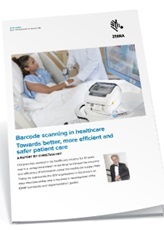STANDARDISED BARCODES DRIVE NEW STANDARDS IN PATIENT SAFETY
Better patient outcomes, fewer errors and increased traceability are just some of the benefits of standardising barcodes.

Whether you're a clinician, healthcare provider or administrator, you'll be affected by the lack of a standard approach to labelling and tracing medicines and medical devices.
Having no standard approach has made it easier for counterfeiters to operate. What's more, manufacturers, distributors and logistics companies often attach their own labels to deliveries, which makes it difficult for clinicians to know which labels to scan. And, in some clinical settings, some types of labelling require clinicians to key in data when scanning barcodes. This can lead to clinical error.
In this expert paper, GS1 Consultant Christian Hay, a leading authority on how to improve the labelling of products in the healthcare supply chain, looks at these issues in more detail – and the steps being taken to resolve them. Written for clinicians, healthcare administrators, IT providers and regulatory bodies, and with insight from leading European figures in the industry, the analysis covers:
The problems caused in clinical settings by the use of multiple types of barcodes
The increased scope for clinical error caused by the use of multiple barcode standards
References to research studies showing the efficacy of using standard barcodes to track medical products across the supply chain
References to research studies showing improvements in care when using barcodes to dispense drugs, track samples, identify patients and create Electronic Health Records (EHRs)
Moves across the industry – both in the US and Europe – to standardise on 2D GS1 barcodes for tracking and tracing medical products and devices
New applications for barcodes such as improving the way people are reminded to take and monitor their drugs and enhancing patient monitoring through wearable devices















